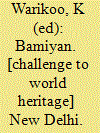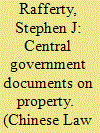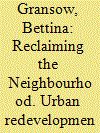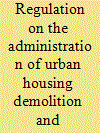|
|
|
Sort Order |
|
|
|
Items / Page
|
|
|
|
|
|
|
| Srl | Item |
| 1 |
ID:
088375


|
|
|
|
|
| Publication |
New Delhi, Third Eye, 2002.
|
| Description |
xx, 252p.
|
| Standard Number |
8186505660
|
|
|
|
|
|
|
|
|
|
|
|
Copies: C:1/I:0,R:0,Q:0
Circulation
| Accession# | Call# | Current Location | Status | Policy | Location |
| 054222 | 726.143/WAR 054222 | Main | On Shelf | General | |
|
|
|
|
| 2 |
ID:
106128


|
|
|
| 3 |
ID:
129529


|
|
|
|
|
| Publication |
2014.
|
| Summary/Abstract |
The urban clearance programmes that were pursued on a vast scale during the Emergency are frequently alluded to by historians but remain poorly understood. In particular, historians have reproduced the assumptions and limited scope of the Shah Commission of Inquiry, which published its reports on the Emergency in 1978. Histories of the Emergency's urban policies have, therefore, focused overwhelmingly on Delhi and north India, on the demolition of buildings, and on the role of Prime Minister Indira Gandhi's son, Sanjay Gandhi, as instigator of these policies. This article uses case studies to demonstrate that these policies were not limited to Delhi and its environs, and to show that a concentration on the demolition of buildings has led historians to neglect the clearing of unwanted people from India's cities. The article goes on to reassess the thinking that underpinned these policies through a case study of Jagmohan, the head of the Delhi Development Authority during the Emergency. It shows how his ideas on urban aesthetics and civics informed the urban clearance programmes and how these authoritarian republican ideas suggest a way of rethinking the history of the Emergency as a whole.
|
|
|
|
|
|
|
|
|
|
|
|
|
|
|
|
| 4 |
ID:
131815


|
|
|
|
|
| Publication |
2014.
|
| Summary/Abstract |
This study examines social interventions into the everyday life of residents, families, and communities during a redevelopment project in an old town neighbourhood of Guangzhou. It further analyses how citizen activism unfolds in response to these redevelopment interventions. To better understand contention over the renewal of an old town neighbourhood - beyond negotiation of compensation for economic losses - the study is structured by a recognition-theoretical model of social conflict following Axel Honneth and Nancy Fraser.
|
|
|
|
|
|
|
|
|
|
|
|
|
|
|
|
| 5 |
ID:
106130


|
|
|
| 6 |
ID:
178752


|
|
|
|
|
| Summary/Abstract |
Communities with large concentrations of migrants, who often live in makeshift and illegal housing, have been common on the margins of large cities in China since the 1980s. Why do so-called “urban villages” persist and even flourish despite repeated government crackdowns? By addressing this question, this article sheds light on a subtle dynamic of city making that has not been fully appreciated by scholarly literature and media reports that have focused on large-scale demolition and eviction in China’s rapid urbanization. Drawing from my two years of field research in Hua village, a community on Beijing’s fringes in line for land expropriation, I explore how multilateral negotiations between local residents (villagers), migrant tenants, the village committee, and municipal government led to a cyclical movement of temporary housing construction, demolition, and extension. The dynamics of recurring demolishment and reconstruction engendered spaces of suspension, which enabled migrants to enter the urban economy at a low cost. Such spaces, however, offered no formal protection or basis for developing lasting social relations, and always faced the prospect of being demolished, but nevertheless were constantly available and even expanding.
|
|
|
|
|
|
|
|
|
|
|
|
|
|
|
|
|
|
|
|
|